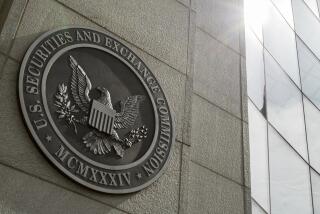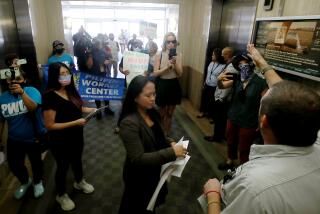Stock-Fraud Suits Increase Despite ’95 Law
- Share via
Despite major legislation 2 1/2 years ago to eliminate frivolous lawsuits, the number of class-action securities fraud suits filed against companies in federal court is growing rapidly and could ultimately cost businesses more than $3 billion, according to a Stanford Law School study released Tuesday.
A total of 66 companies were sued for fraud in the first quarter, more than double the number a year earlier, the report found.
If the first-quarter rate were to hold through the year, total securities fraud litigation filed in 1998 would be a startling 49% higher than the annual average in the five years before the landmark legislation took effect in December 1995.
Judging by historical payout patterns, companies--many of them in California--eventually might have to shell out $1.8 billion to $3.1 billion to settle the suits.
“This is a booming business,” said Joseph Grundfest, a Stanford law professor who is a coauthor of the study.
The surge comes despite a dramatic effort by Congress in 1995 to staunch what many companies--and legislators--say are meritless fraud suits filed on behalf of angry shareholders whose stocks have dropped.
The Private Securities Litigation Reform Act sought to make it much tougher to pursue such suits in federal court. Companies complained that they were incurring enormous legal fees to fight the suits, which often allege that a company’s plunging stock price resulted from management fraud, not simply market forces.
Because companies fear losing much heftier sums in jury verdicts, they settle the majority of fraud suits. Companies petitioned Congress that they were virtually forced to settle dubious cases brought by a small coterie of plaintiffs’ attorneys specializing in suing them.
Plaintiffs lawyers typically get about one-third of the amount recovered in these cases.
Historically, many of the suits have targeted small technology companies with rapidly evolving businesses and volatile stocks. That is still the case: The study found that 58% of companies sued in the first quarter were in tech, up from 43% in 1996.
Twenty-seven percent of the first-quarter suits were brought against California companies.
Critics of the 1995 law argued that it would thwart the ability of individual investors to recover damages from companies that intentionally misled them into paying inflated prices for shares.
The law made it harder to bring successful suits by requiring, among other things, that plaintiffs show early in the process that a company’s executives specifically intended to defraud investors.
*
But so far, the only clear result of the law seems to be a dramatic slowdown in the process by which cases are resolved.
Prior to the law, cases were typically resolved within two years, Grundfest said. About 20% of all cases are dismissed and the vast remainder are settled. Fewer than 2% go to trial.
In the wake of the new law, fewer than 30 of the at least 380 cases brought in the last 2 1/2 years have been resolved. The backlog has occurred because of tremendous uncertainty over the practical application of the new rules covering such suits, and conflicting rulings in a series of lower court decisions.
Still, as the cases wear on, companies’ legal expenses mount.
The number of suits is on the rise in part because of the “bifurcated” stock market, Grundfest said. While big blue-chip stocks have rocketed in recent years, many smaller stocks have been weak.
Any company that falls short of market earnings expectations--for whatever reason--can see its shares devastated.
The nature of fraud complaints has changed since the law was passed. Previously, many suits charged that companies intentionally overstated their prospects when providing estimates of their future performance.
Now, however, more suits allege that companies used fraudulent accounting practices to overstate their earnings. Some of the suits also charge that corporate insiders sold shares at high prices, knowing that their company was using illegitimate accounting.
As in the past, some of the cases appear to have merit, while others don’t, experts say.
“You see cases you don’t understand and are surprised they’re continuing to be filed, and you see cases you’d expect to be resolved” because they have merit, said Cynthia Zollinger, managing director at Menlo Park-based Cornerstone Research, a litigation consulting firm.
*
Despite the 1995 law, the rise in suits filed suggest that lawmakers still face the problem of how to wipe out costly bogus suits while still giving shareholders a way to go after truly fraudulent businesses.
“Ideally, we want to drive fraud out of the market and we want to do it without frivolous lawsuits,” Grundfest said. “That’s a tough balance to strike.”
Immediately after the law was tightened, the number of securities fraud lawsuits in state courts rose as plaintiffs attorneys tried to circumvent the toughened federal requirements. But state suits have tailed off recently as the number of federal cases has risen again.
More to Read
Inside the business of entertainment
The Wide Shot brings you news, analysis and insights on everything from streaming wars to production — and what it all means for the future.
You may occasionally receive promotional content from the Los Angeles Times.










